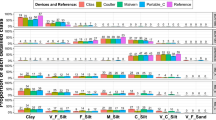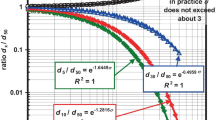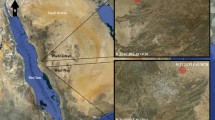Abstract
Relative percentages of sand, silt, and clay from samples of the same till unit are not identical because of different lithologies in the source areas, sorting in transport, random variation, and experimental error. Random variation and experimental error can be isolated from the other two as follows. For each particle-size class of each till unit, a standard population is determined by using a normally distributed, representative group of data. New measurements are compared with the standard population and, if they compare satisfactorily, the experimental error is not significant and random variation is within the expected range for the population. The outcome of the comparison depends on numerical criteria derived from a graphical method rather than on a more commonly used one-way analysis of variance with two treatments. If the number of samples and the standard deviation of the standard population are substituted in at-test equation, a family of hyperbolas is generated, each of which corresponds to a specific number of subsamples taken from each new sample. The axes of the graphs of the hyperbolas are the standard deviation of new measurements (horizontal axis) and the difference between the means of the new measurements and the standard population (vertical axis). The area between the two branches of each hyperbola corresponds to a satisfactory comparison between the new measurements and the standard population. Measurements from a new sample can be tested by plotting their standard deviation vs. difference in means on axes containing a hyperbola corresponding to the specific number of subsamples used. If the point lies between the branches of the hyperbola, the measurements are considered reliable. But if the point lies outside this region, the measurements are repeated. Because the critical segment of the hyperbola is approximately a straight line parallel to the horizontal axis, the test is simplified to a comparison between the means of the standard population and the means of the subsample. The minimum number of subsamples required to prove significant variation between samples caused by different lithologies in the source areas and sorting in transport can be determined directly from the graphical method. The minimum number of subsamples required is the maximum number to be run for economy of effort.
Similar content being viewed by others
References
Jacobs, A. M., and Lineback, J. A., 1969, Glacial geology of the Vandalia, Illinois, region: Illinois Geol. Survey Circ. 442, 23 p.
Willman, H. B., and Frye, J. C., 1970, Pleistocene stratigraphy of Illinois: Illinois Geol. Survey Bull. 94, 204 p.
Author information
Authors and Affiliations
Rights and permissions
About this article
Cite this article
Jacobs, A.M. Statistical considerations for grain-size analyses of tills. Mathematical Geology 3, 227–238 (1971). https://doi.org/10.1007/BF02045793
Received:
Issue Date:
DOI: https://doi.org/10.1007/BF02045793




